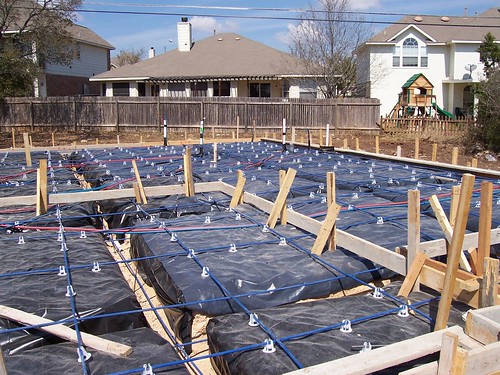 Traditional rebar (but blue!) in place and ready for concrete to be poured for a foundation. Photo by Flickr user GeekMojo
Traditional rebar (but blue!) in place and ready for concrete to be poured for a foundation. Photo by Flickr user GeekMojoTraditionally, concrete slab foundations are reinforced with steel bars, called re-bar (or rebar) -- short for "reinforcing bars." This technique of reinforcing concrete and similar materials originated in 1867 with a French florist named Joseph Monier. His experiments in making a stronger flower pot ultimately led to embedding reinforcing bars in the pots as they were formed and before they were kiln dried.
Post-tensioning concrete foundations are the next wave beyond traditional concrete slabs. With post-tensioning slabs, high-strength steel strands or cables, typically referred to as tendons, create a grid of steel cables that actively support the slab. Traditional rebar construction is "inactive" only really helps keep the slab intact
after the slab has cracked. Slabs with post-tension cables are usually thinner and this can cut down on curing time and, ultimately, construction costs.
 Post-tensioning being used in the construction of a concrete bridge for a highway. Photo courtesy of the Kansas Department of Transportation
Post-tensioning being used in the construction of a concrete bridge for a highway. Photo courtesy of the Kansas Department of TransportationPost-tension concrete foundations are used not only in home construction, but in commercial construction. Since this method combines structural integrity and thinner pads, office buildings can have thinner floors but retain comfortable ceiling heights, which in turn reduces total building height and weight load.
Caveats
With all that said, one must keep in mind that post tension foundations do not solve the underlying soil's ability to handle moisture. That is, just because a home or business is built on a foundation with post tension cables, it doesn't mean that the soil on which that foundation rests quits expanding and contracting as the moisture content changes. Post tension foundations can still shifting or even failing. You must still perform essential foundation maintenance, such as maintaining a consistent moisture content within the soil, keep tree roots at bay, and watching for signs of foundation failure like cracks in the wall, stuck doors and windows, wrinkled wallpaper, and popped or loose floor tiles.
If a builder tells you that a post tension foundation solves all your problems and you'll never have to worry, then
run — don't walk — and find yourself another builder! Remember, the builder is trying to sell you the house, but you're the one who must live with the purchase for years to come.
Have questions or want more information? Then visit us at
www.AceFoundation.com or give us a call at 972-272-1900.






